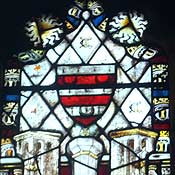 Methley Church
Methley Church Methley Church
Methley ChurchWild West Yorkshire, Sunday 17 October 2010
previous | this month | next
 THE WATERTON CHAPEL at Methley Church contains the tombs of the Waterton and Savile families. During the period of the Wars of the Roses, a Waterton heiress married Lionel, Lord Welles (right). A supporter of the Lancastrian cause, he was slain at the Battle of Towton, 1461, which was fought nine miles to the north east. It will be the 550th anniversary of the battle on 29 March 2111.
THE WATERTON CHAPEL at Methley Church contains the tombs of the Waterton and Savile families. During the period of the Wars of the Roses, a Waterton heiress married Lionel, Lord Welles (right). A supporter of the Lancastrian cause, he was slain at the Battle of Towton, 1461, which was fought nine miles to the north east. It will be the 550th anniversary of the battle on 29 March 2111.
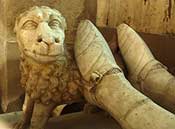 I like the heraldic lion at Lionel's feet. The medieval sculptor can be forgiven for giving the lion such human looking eyes as in 15th century England he probably had limited opportunity to observe lions in real life, unless he had visited the menagerie at the Tower of London. He must surely have had access to Lord Welles' armour as it is perfect in every detail; he wears the garter that shows he was a Knight of the Garter.
I like the heraldic lion at Lionel's feet. The medieval sculptor can be forgiven for giving the lion such human looking eyes as in 15th century England he probably had limited opportunity to observe lions in real life, unless he had visited the menagerie at the Tower of London. He must surely have had access to Lord Welles' armour as it is perfect in every detail; he wears the garter that shows he was a Knight of the Garter.
The sculptor had more scope of artistic expression in his almost abstract treatment of the folds of Lady Welles' gown.
The bloody rivalry of the Wars of the Roses makes me feel that the 15th century must have been a barbaric period but even after some 50 to 80 thousand men, including 28 lords - almost half of the peerage at that time - were slaughtered at Towton it was possible to engage a talented sculptor to create this tomb.
The alabaster tomb effigies in the Waterton Chapel were an inspiration to the young Henry Moore who attended Castleford Secondary School (which later became the Grammar School). In 1989 the tombs, then threatened by a damp which had penetrated the alabaster, were restored at his expense. The drapery of the gowns in particular reminds me of Henry Moore's drawings, such as those he made of people sleeping on the platforms of underground stations during World War II air raids.
In A Land by Jacquetta Hawkes, she describes the Midlands alabaster that was prized by medieval sculptors and there's a Henry Moore drawing of 'Knights and kirtled ladies waiting for creation' in the bedding planes of the alabaster.
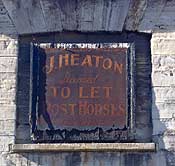 The Swan at Aberford
The Swan at Aberford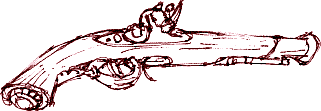 We're at a historic location for lunch; The Swan at Aberford on the old A1 was originally a coaching house. The arched entrance to the yard would accommodate a coach and horses (although I'd be careful to duck my head if I was an outside passenger) and on the stables at the back of the yard there's an original sign advertising 'post horses to let'.
We're at a historic location for lunch; The Swan at Aberford on the old A1 was originally a coaching house. The arched entrance to the yard would accommodate a coach and horses (although I'd be careful to duck my head if I was an outside passenger) and on the stables at the back of the yard there's an original sign advertising 'post horses to let'.
In the 17th century, this stretch of the Great North Road was notorious for the activities of highwayman John Nevison. Luckily he hung up his pistols many years ago. In fact, could that be one of his pistols mounted on the wall above our corner table?
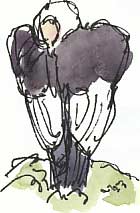
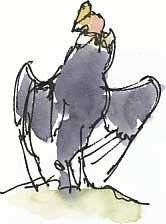 Lotherton Bird Garden
Lotherton Bird GardenThere have been big improvements to Lotherton Bird Garden since our last visit, way back in the early 1990s. The Andean condors now have a lofty aviary which I assume is large enough to accommodate their 9 to 10 foot wingspan, although today the pair were preening and basking in the sun. The information board points out that condors were 'revered as gods of the sky' by Andean people.
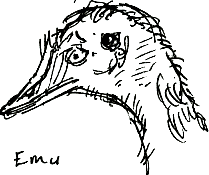
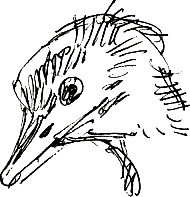 The emus were pecking at the mesh at the front of their enclosure. They look startlingly like dinosaurs when you can get up close to them with their scaly feet and - to me - rather manic eyes. Perhaps that's because I can't help thinking of the oft-shown clip of the late Rod Hull's appearance on Michael Parkinson's chat show with his life-size emu puppet, an alarming creation that savaged the interviewer. The neck of the emu looks strong and muscular, very similar to the proportions of a man's arm.
The emus were pecking at the mesh at the front of their enclosure. They look startlingly like dinosaurs when you can get up close to them with their scaly feet and - to me - rather manic eyes. Perhaps that's because I can't help thinking of the oft-shown clip of the late Rod Hull's appearance on Michael Parkinson's chat show with his life-size emu puppet, an alarming creation that savaged the interviewer. The neck of the emu looks strong and muscular, very similar to the proportions of a man's arm.
There's a large walk-in aviary which is a wonderful place to draw birds - I've got it on my list of places to go back to. You don't have to peer through glass or mesh. It seems so free and easy being able to draw the black-crowned night heron which was sitting by the water's edge just a few yards from me and then to have it spread its wings and fly past my head on the way to a shelter, to which the birds can retreat if they wish, at the top end of the rocky cataract at the far end of the aviary.
The black-crowned night heron is the world's most common species (that's another fact I've gleaned from Chris Packham's Nature Handbook, which I reviewed in yesterday's diary).


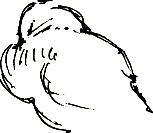
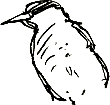
![]()
Richard Bell, illustrator
previous | this month | Wild West Yorkshire home page | next